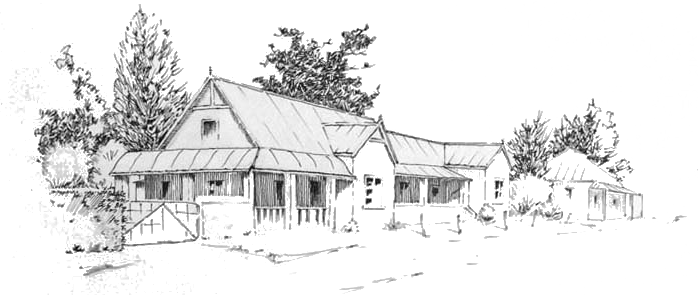Wild Trout Association celebrates 20th anniversary
By Ed Herbst

Most countries where fly fishing is practised have organisations that promote the sport or a specific fish species. The USA, for example, has Trout Unlimited and the Federation of Flyfishers and the UK has the Grayling Society.
In South Africa we have the Federation of Southern African Fly Fishers (FOSAF) http://www.fosaf.co.za/ and the Wild Trout Association http://www.wildtrout.co.za/.
The Wild Trout Association was started on the 18th April 1991 as a means of creating a mutually rewarding link between farmers and fly fishers and it now administers more than 350 kms of water. The Association, which is based in Rhodes, organises day ticket fishing for visitors, giving approximately 70% of the rod fee to the riparian owner and retaining the rest for admin fees.

Dave Walker
My research into the origins of the Wild Trout Association reveals the following: In September 1990, Dave Walker, a friend of the well-known Moshesh’s Ford farmer, Basie Volsoo moved to a farm owned by Basie in the Bokspruit valley. The idea was to set up a farm holiday enterprise based on horse trails, wing shooting and as an afterthought, fly fishing.
Whilst renovating his eventual place of residence on the farm Tipperary, Walker lived in the cottage - known as the “Honeymoon Cottage” - on Gateshead farm, at the very end of the road in the Bokspruit Valley. This is a place of spectacular beauty. http://www.gateshead.co.za/

Basie Vosloo on the steps of 'Honey Moon Cottage'
It can however be a somewhat lonely place so Walker sought company. He duly invited a charming young woman to visit. On the day of her arrival, Basie phoned to say that a friend of his would be coming to Gateshead to fish.
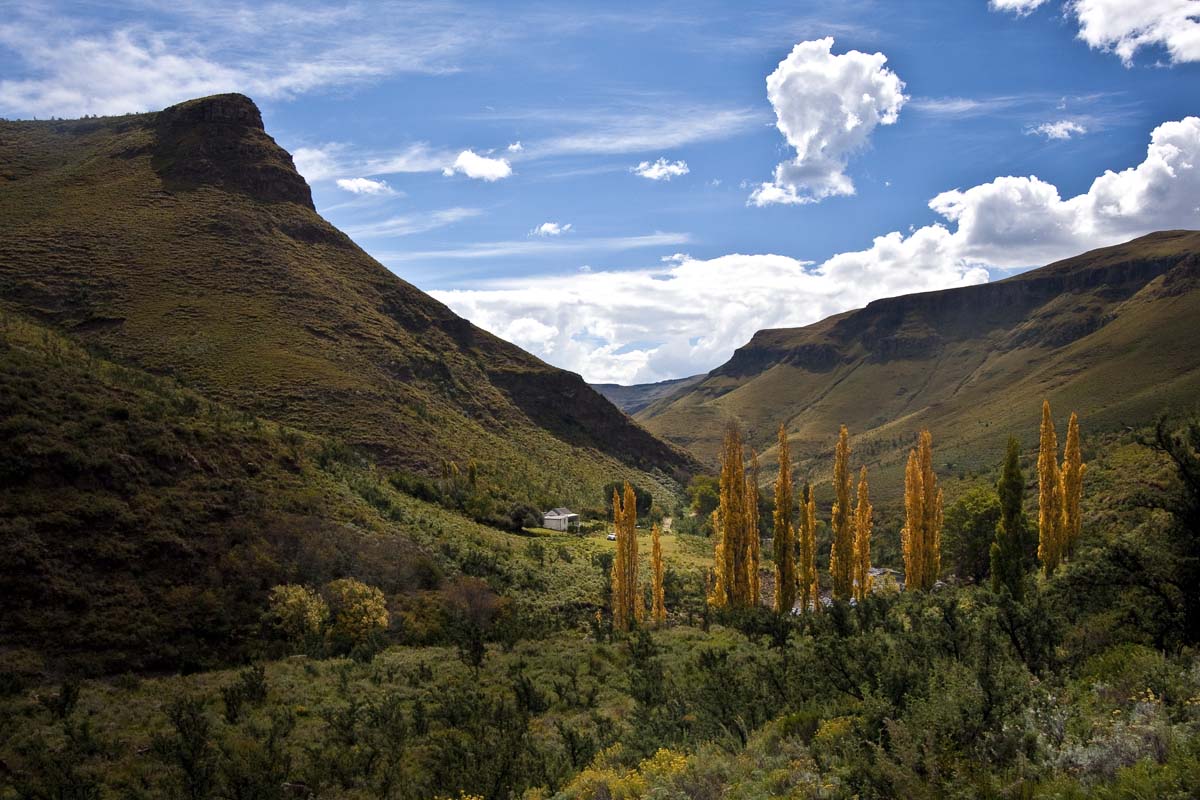
The spectacular beauty of Gateshead
Martin Davies, an expatriate Welshman, ichthyologist at Rhodes University and a fly fishing junky of note, duly arrived and, with surprisingly little chatter, took off up the valley to pursue his favourite daylight pastime. Walker and friend settled into sundowners, a fire was lit and darkness enveloped the valley. With a pale moon rising to the hooting of owls, Walker’s companion became worried about the fate of Davies who had yet to return. Walker, urged on by his lady friend, wound up the vintage telephone on the local party line and contacted Vosloo, who said the he shouldn’t embark on a search and possible rescue mission as he knew “FA about the mountains”. He then added that he would drive up himself to help with the search. Needless to say, Davies duly arrived, safe and sound on his stocky Welsh legs, almost simultaneously with Vosloo, thus vindicating those who had bestowed upon him the nicknames of “Punctual Martin Davies” and “The Late Martin Davies”.
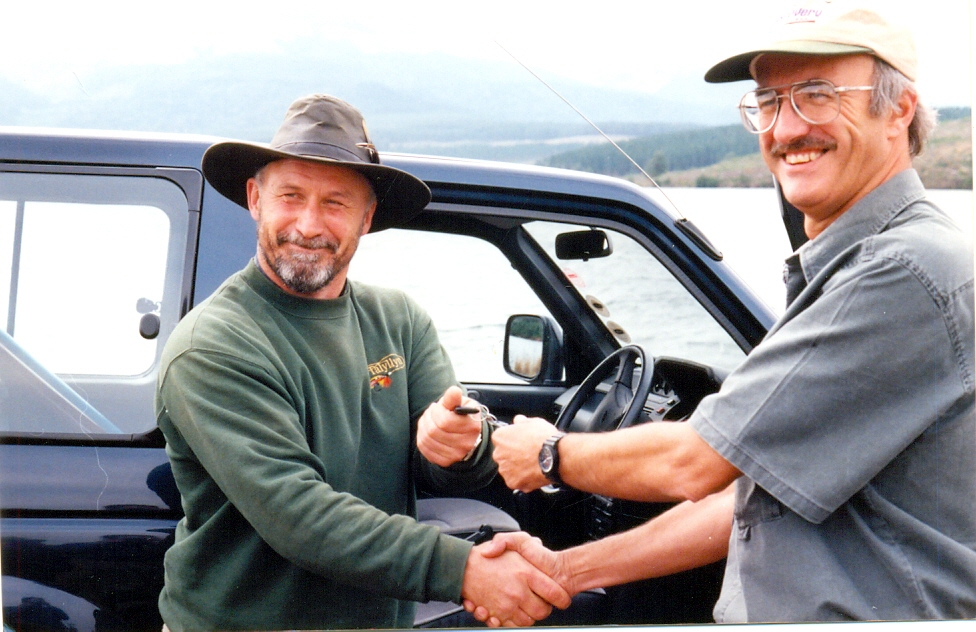
Alan Hatton (right) of Mitsubishi hands the keys of FOSAF’S Samcor/Mondi-sponsored Pajero to aquaculturist, Martin Davies of Rhodes University.
A bottle of whisky appeared and soon the three, sans young lady, ensconced themselves in the kitchen and set about destroying the “Scottish medicine”. This, coupled with a few beers for the thirst, stretched the night on into the early hours, much to the dismay of the young lady – who, after such an introduction to Walker and company, was never seen there again!
At the time, Walker had a vision of establishing a conservancy in the area. Davies had a vision of a sport fishery in the area. Lengthy debates ensued and finally, a start was made on a constitution for a “conservation-based sport fishery”. Needless to say, for those who know Davies, this was not a short process. Ultimately, many hours later, the final version was typed up and presented to potential founder members who, at that time, consisted of Basie Vosloo, Graham and Margy Frost, Grant & Kathy Sephton and Marius and Debbie Robertson, all farm owners in the area. The sum total of water under their control amounted to 42km. A flyer with text and a map was printed and proudly distributed. The flyer was 1/3 of an A4 page printed on both sides.

Basie Vosloo
Dave Walker was coerced into standing as chairman, a job which he duly undertook. It emerged many years later that this move had been plotted by Graham and Margy Frost together with Martin Davies and several other founder members!
To bring the new Association to the attention of a wider audience Walker and company duly organised the BWTA Expo, a gathering attended by fly fishing enthusiasts, myself included, from all parts of South Africa. This is what I wrote at the time in Piscator, journal of the Cape Piscatorial Society.

Dave Walker, Margie Frost and Ed Herbst at the 1992 BWTA Expo
The Barkly Wild Trout Association is unusual in concept in that it enables the riparian owners in the Barkly district to develop, improve and make available for public usage their streams. rivers and dams while retaining autonomous control of their property.
The Barkly Wild Trout Association is thus the first organisation of its kind in South Africa where riparian owners have come together to help each other develop a natural resource for the benefit the Barkly East community at large and the fly fishing public in general.
The Expo was opened by the Chairman of the President's Council, Dr Willie van Niekerk. In his speech Dr van Niekerk said that the principles upon which the Association is founded are sound and to be welcomed precisely because they counter the threat of syndication which, in some areas has made fly fishing for trout a sport to which only the affluent have access. He said that contrary to normal syndication practice where the farmer cedes control of his water to the syndicate, the association's constitution leaves that control firmly vested in the farmer.
Dr van Niekerk noted that the Association's members control only one hundred kilometres of the estimated one thousand kilometres of river fly fishing available in the district and called on other farmers to join the Association.
"If we can attract fly fishers to this area in significant numbers the ripple effect will be felt throughout the local economy. Such anglers stay at local hotels, fill up their vehicles at local garages and buy a wide range of consumer goods from soft drinks to newspapers and periodicals," he said.
Fishing was provided on the Karnemelk, Kraai, Sterk. Bok, Joggem and Langkloof Rivers and the picturesque, Willow Stream.

The Karnemelk stream
To someone accustomed to the gaunt, stark beauty of the Cape' s mountain streams the gentle, pastoral beauty of the rivers in Barkly came as a pleasant surprise. To those who fish the rivers of the Eastern Transvaal however, there was much to make them feel at home.
The Joggem, for example is a typical Eastern Transvaal-type river with classic riffles and runs. It has long stretches of deep and slow water, alternating with faster, shallower water which demand a versatile approach and test one's river craft to the maximum.

The magnificent Joggem valley
The Langkloof, is a shallow meandering river but its deep pools hold the leviathans for which the region is famous. This river, and the Kraai into which it flows are really big rivers and its fish call for stout tippets.
Up at Moshesh’s Ford, the Kraai resembles a miniature Fish River Canyon, with a sheer drop of a hundred metres from the road to the river far below. Boulders as big as a small house litter the riverbed and its deep green pools clearly have big fish potential.
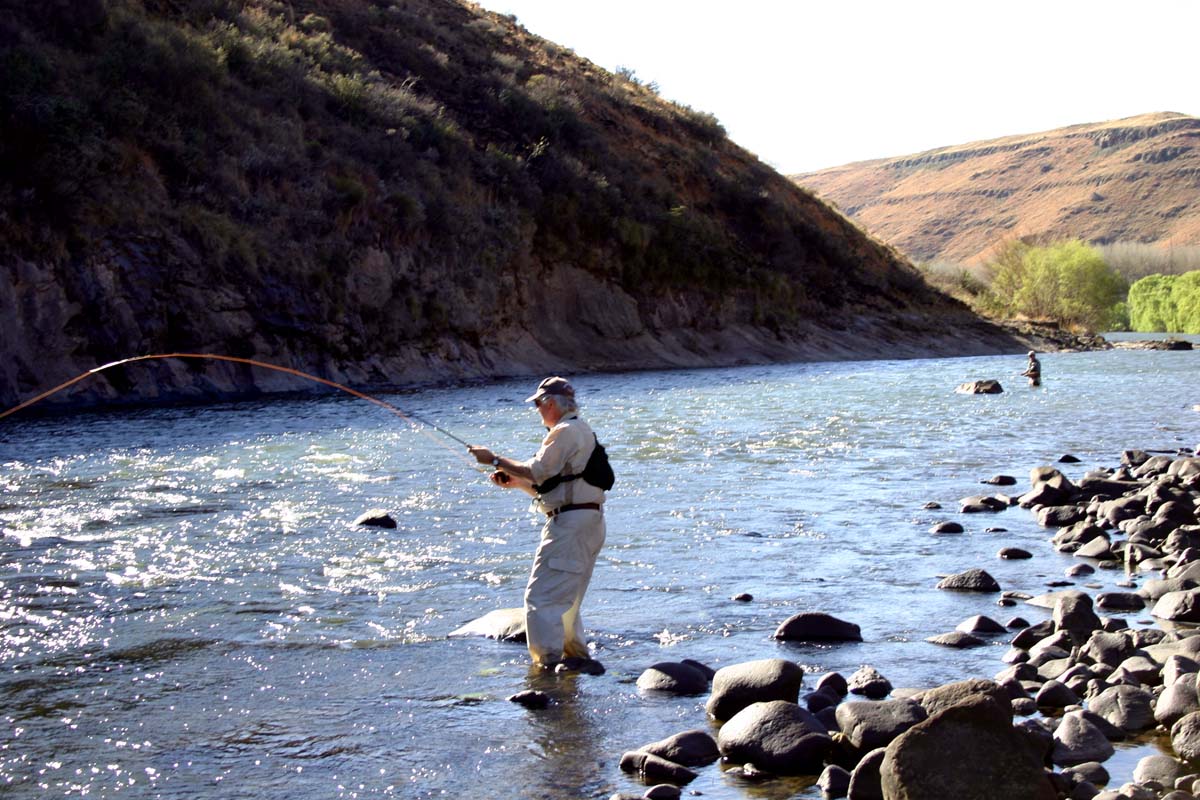
The Kraai
The Expo participants averaged about seven to 10 fish a day and several hundred trout were caught and released in the three-day period.
For someone who loves small streams however, the aptly named Willow Stream is hard to beat.
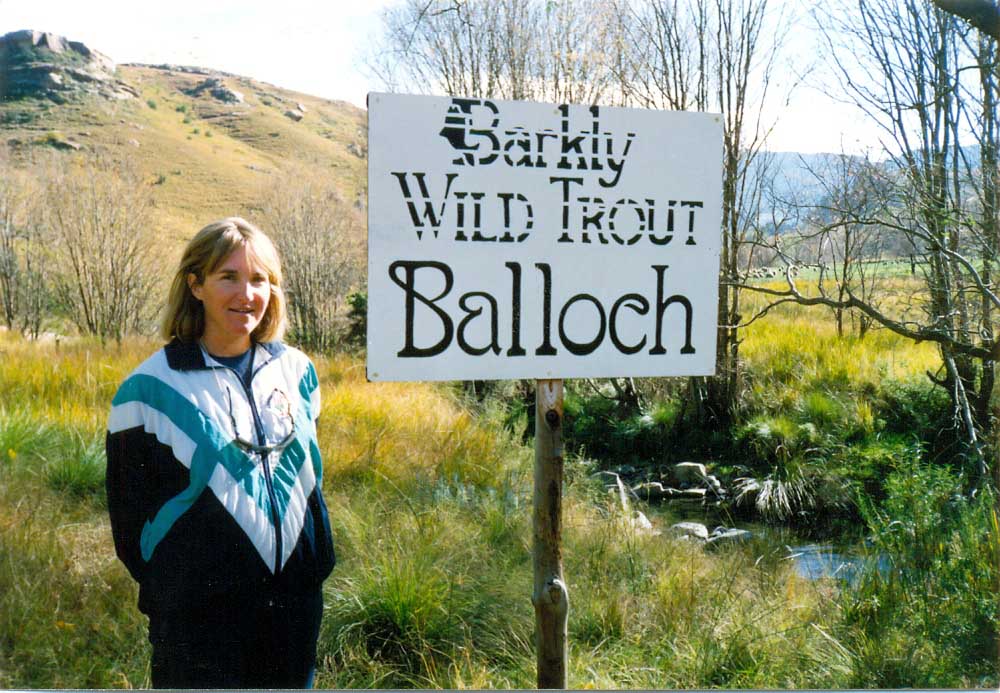
Margie Frost
When the other rivers are running too high or too low to be fishable, the Willow provides a welcome retreat. For much of its length it runs through the farm, Balloch, belonging to Graham and Margie Frost. There can be few streams in the country set in more beautiful surroundings. The Frosts are the third generation of their family to farm Balloch and, since the 1920s, thousands of British trees such as elm, beech and oak have been planted. These trees were chosen because of the high rainfall in the area.
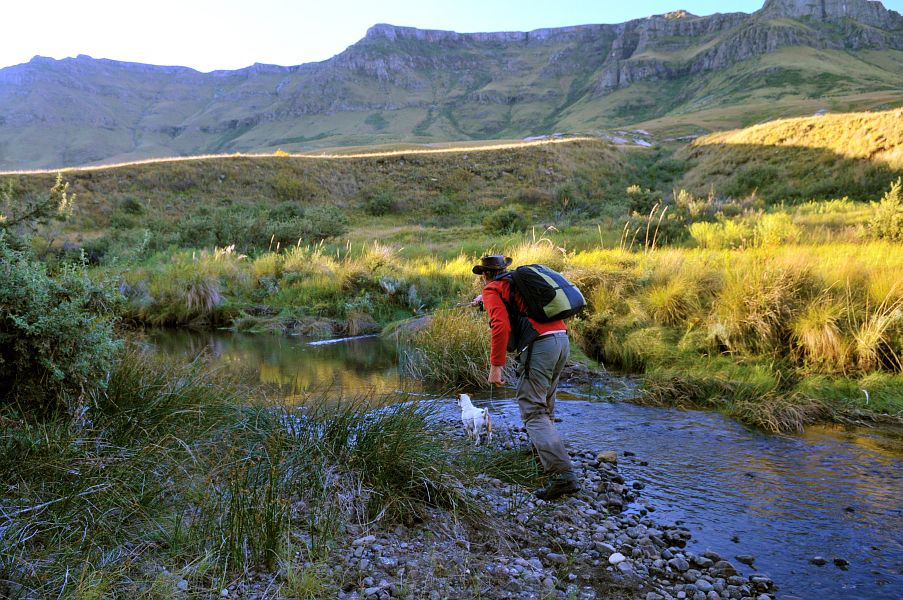
The Willow stream
During the Expo these trees had taken on their autumnal hues and the upper Willow was ablaze with colour. Although fish of up to a kilo have been taken on the Willow, the majority of its fish are smaller but there are many of them and its merry disposition and beautiful surroundings make it the sort of water on which one fishes one and two weight rods with enormous pleasure. It tends to run slightly more milky than the ultra-clear Western Cape streams and fishing small nymphs (14-16) with a strike indicator about a metre from the fly seems to be the most effective method.
High above one wheel tiny black dots - vultures from a colony in the towering krantzes nearby and the knowledge that the upper reaches of the Willow have been recently stocked with brown trout creates an angling environment which is not only unusual but well-nigh irresistible.

A Balloch brown trout
Dr van Niekerk’s words about the contribution that fly fishing could make to the North Eastern Cape highlands proved prescient.
The Association has seen more and more farmers joining as they realised that it provided both controlled access and an income from the rivers, streams and dams. Currently, a day permit costs R150/rod/day of which R110 accrues to the riparian owner and R40 is retained by the WTA for administration and marketing. As a result, the Association now provides access to more than 350 km of rivers and streams – a substantial increase from the 42 km provided twenty years ago.
A recent study by Dr Marius du Preez and Deborah Lee of the economics department at the Nelson Mandela University in Port Elizabeth concluded that fly fishing tourism in Rhodes plays a beneficial role in an area where poverty is endemic and most of the residents are unemployed. According to the data collected by du Preez and Lee, some 700 fly fishers visit Rhodes during the traditional angling season and contribute almost six million rand a year to the Rhodes economy. In the process 39 jobs have been created.
(du Preez, Mario and Lee, Deborah E.(2010) 'The contribution of trout fly fishing to the economy of Rhodes, North Eastern Cape, South Africa', Development Southern Africa, 27: 2, 241 — 253
To link to this Article: DOI: 10.1080/03768351003740654)
URL: http://dx.doi.org/10.1080/03768351003740654
The focal point of the WTA in Rhodes is Walkerbouts Inn – run by Dave Walker and a profile on him will soon be posted on this site.
http://www.walkerbouts.co.za/welcome.html
Dave has been tireless in his promotion of tourism in the area in general and fly fishing in particular. http://www.wildtrout.co.za/
The distance by road from major cities such as Durban, Cape Town and Johannesburg can be as much as 13 hours in driving time and many people prefer to fly to Bloemfontein and hire a car, thus reducing the driving time to about four hours.
Further links of interest:
http://www.wartrail.co.za/Balloch(2078646).htm
http://www.ballochcottages.co.za/index.php/bookings
http://www.fishingowl.co.za/hfft%2013b.html

